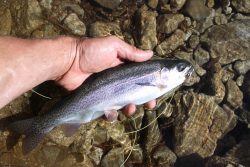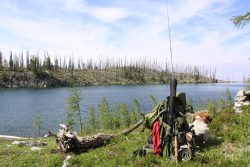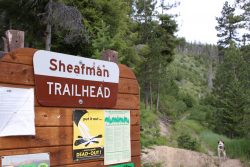Snow capped peaks surrounded the pristine lake as line from my fly rod lay floating on the waters’ surface. The shoreline was cluttered with large boulders severed from nearby cliffs sometime in the last few hundred years. The weather at this altitude felt like early spring although my calendar told me it was August. The crystal clear water revealed a fish swimming just under the surface. I waited patiently. The trout turned slowly then shot straight up from the cold mountain lake and engulfed my feathered imitation. I set the hook and watched as every head shake could be seen in the crystal clear Rocky Mountain lake. This self guided trip was turning up so many fish I just couldn’t believe it. The natural beauty of the western mountains adds an element of wildness even to the native cutthroat, bull trout, and grayling thriving in these untouched lakes and streams. The legendary rivers and streams in Montana are well known for high quality trout fishing opportunities. Expensive guided float trips on blue ribbon trout streams can provide extraordinary fishing days, but with beautiful landscapes and lakes filled with trout laying just over the next ridge for free, who can resist?

Planning a trip to fish Montana’s back country lakes isn’t hard but if you’re looking for great fishing action and solitude you should know a few things about these lakes. Things like 50% of the lakes in any given mountain range could be fishless. This is based on personal experience and not some factoid web search. However, the Montana FWP web site has an amazing data base found at: http://fwp.mt.gov/fishing/mFish/ that can provide all the information you need to know what the fishing opportunities are – and what they are not. Information like “Fishless” versus “Rainbow Trout” along with stocking data lets you know what to expect.
Literally thousands of lakes and streams can be found within hiking distance of main roads throughout the western states. The opportunities for a multi-species fishing adventure are endless as any combination of species can be caught using simple tackle you already have sitting in your closet. Your backcountry adventure will require some planning and effort on your part, but the rewards are remarkable.
TIMING
Time of year is the most important consideration for planning a fishing trip to remote western lakes. While your favorite local fishing hole may be approaching the dog days of summer, high mountain lakes are just coming to life after a long winter. July and August are excellent months to find ice still lingering along the shoreline and trout ready to feed on anything you can tie onto the end of a line. Nothing can be more disappointing than to hike 6 or 8 miles to a frozen lake or to be turned around by deep snow. Fish and wildlife, and national forest service agencies are excellent resources for determining the accessibility of specific areas. Many of the backcountry lakes throughout the west are very much wild and rarely fished, another reason to load up your backpack with fishing gear and start hiking.
SPECIES
One of the best things about fishing in remote areas is the opportunity to catch multiple species of trout not found in many parts of the country. A dedicated angler could be catching golden trout from a lake just twenty acres in size one day and pulling cutthroats’ from a stream the next. An occasional bull trout can be hooked as well. Bull trout are a threatened species listed under the Endangered Species Act and should not be targeted specifically, but catching one of these spectacular fish is not uncommon. Carefully handling these fish is paramount to their recovery. An encounter with this Rocky Mountain icon adds a special element to the experience. The bull trout looks similar to the brook trout, so careful identification is important.
Mountain whitefish can also be found along with arctic grayling lurking in the water in certain areas, providing for consistent action due to their aggressive nature. With so many species to pursue, careful planning should be done to ensure you fish the right lakes for the species you are after. Taxidermists are often helpful and seem to know where the best fishing is. Seeking out local people “in the know” will be a big part of your success. Online fishing reports should not be overlooked, as they often include specific information by anglers who have fished back country areas recently or at the same time of year you will be there. This type of information will help avoid pitfalls.
CONDITIONING AND GEAR

A three mile hike may take one hour or three depending on terrain, your physical ability and the amount of gear on your back. Getting in shape before heading into the back country is important, but the most common mistake backpackers make is packing too heavy. A lightweight synthetic sleeping bag squeezed into a small compression stuff sack will give you more room in your pack, but that shouldn’t translate into filling up the empty space with your kitchen sink. Necessary items include a lightweight shelter, sleeping bag, extra long sleeved shirt, light weight long pants with zip off legs, synthetic socks, sturdy boots, a pile shirt, long underwear, sunglasses, brimmed hat, light weight rain gear, flashlight, a lightweight folding chair (such as a crazy creek chair which doubles as a sleeping mat) , map and compass (know how to use them) or a GPS, a one burner cook stove and lighter, lightweight cookware, knife, food and of course fishing gear. Make sure your clothing is made from material that dries quickly and will maintain some warmth even when wet. Extra gear may provide more comfort, but will also add extra weight. A light action rod and reel combo, small tackle box with several choice lures or flies and a spool of line should be all the tackle you’ll need.
BACKCOUNTRY OPPORTUNITIES
While getting deep into the backcountry can provide all the ingredients for solitude and great fishing, not all the best lakes require an overnight stay. One of my favorite lakes to fish is only one mile from the trail head. The old trail is very steep and no longer maintained. After a little legwork and about an hour of my time, I have a lake with honest 20 inch cutthroat all to myself. Opportunities like these can be found virtually all over the Rocky Mountains. Exploring these wild areas provides excellent opportunities for older anglers and kids – or for those less inclined to stay overnight in the wilderness. Great views and fishing can be had by planning day trips into remote or high altitude lakes and then returning to the comfort of a motel or base camp. The options are endless for planning a custom backcountry fishing adventure to suit your needs. There may be a million reasons pursue these unique opportunities, but one of my personal favorites-backcountry fishing offers the savvy hunter excellent pre-season scouting opportunities. A fact to consider when planning your next adventure.
WHERE TO START

In Montana check out Forest Service Maps for the Absaroka-Beartooth, Bitterroot and Bob Marshall Wilderness areas. Idaho’s Selway Bitterroot and Frank Church wilderness areas offer incredible solitude and great fishing as well. The countless lakes and drainages in these areas could keep you busy for years. A tip here – once you locate the maps and start adding up the miles and number of lakes you’re going to fish, give a quick phone call to the local fisheries biologist. This single aspect of trip planning is the most over looked and simple way to guarantee a successful trip. Call and ask about trail conditions, fish distribution, fishing pressure, which lakes are best for your goals- This resource is invaluable!
Of course Glacier, Yellowstone and Grand Tetons National Park offer opportunities. Call park head quarters for fishing information.
The backcountry fishing experience is as unique as the angler planning the adventure. Thousands of lakes and streams are accessible and the possibilities’ are endless. The simple beauty of these lakes hidden just out of view from highways and towns throughout the west will draw you over the next ridge time and time again. A self guided trip into the western wilds is one of the few true adventures remaining where first rate fishing opportunities can be attained without spending a small fortune. Solitude, adventure and great fishing are at your fingertips.